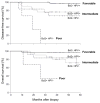Impact of human papillomavirus on oropharyngeal cancer biology and response to therapy: implications for treatment
- PMID: 23910468
- PMCID: PMC3740406
- DOI: 10.1016/j.otc.2013.04.009
Impact of human papillomavirus on oropharyngeal cancer biology and response to therapy: implications for treatment
Abstract
Oropharyngeal squamous cell carcinoma (OPSCC) originating from human papillomavirus infection has emerged as a new entity in head and neck cancer, defining a subset of patients with distinct carcinogenesis, risk factor profiles, and clinical presentation that show markedly improved survival than patients with classic OPSCC. De-escalation of therapy and identification of relevant biomarkers to aid in patient selection are actively being investigated. This review addresses the implications of these findings in clinical care.
Keywords: Clinical implications; HPV-positive oropharyngeal cancer; Treatment implications.
Copyright © 2013 Elsevier Inc. All rights reserved.
Conflict of interest statement
Figures




References
-
- Begum S, Cao D, Gillison M, et al. Tissue distribution of human papillomavirus 16 DNA integration in patients with tonsillar carcinoma. Clin Cancer Res. 2005;11(16):5694–5699. - PubMed
-
- Gillison ML, D’Souza G, Westra W, et al. Distinct risk factor profiles for human papillomavirus type 16-positive and human papillomavirus type 16-negative head and neck cancers. J Natl Cancer Inst. 2008;100(6):407–420. - PubMed
Publication types
MeSH terms
Substances
Grants and funding
LinkOut - more resources
Full Text Sources
Other Literature Sources

